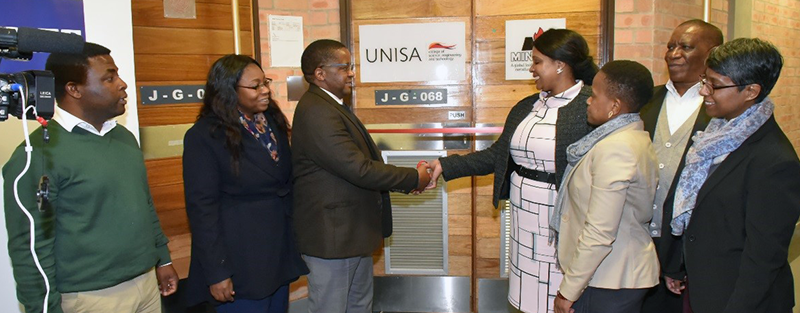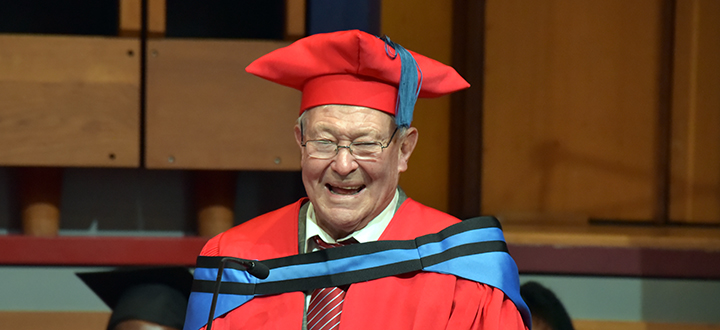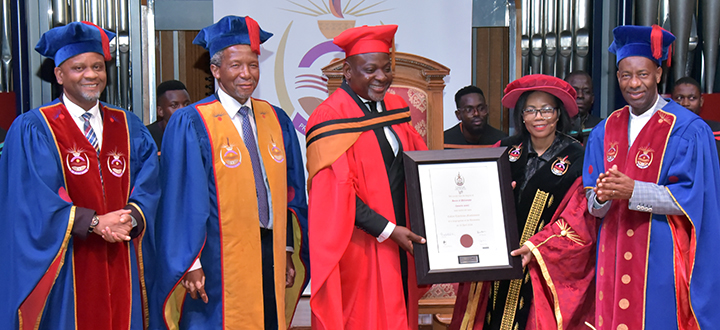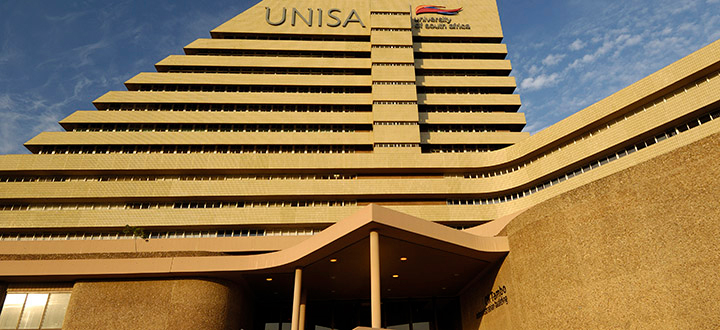News & Media
Unisa and Mintek partner for science
Mintek and Unisa’s College of Science, Engineering and Technology (CSET) are proud to announce their joint acquisition of a state-of-the-art 3D X-ray microscopy system. 3D X-ray imaging of advanced materials, rocks, and minerals facilitates the ability to “see what’s inside”, without physically breaking down the sample. The instrument, which produces images similar to those from a CT scan that is used for imaging the human body, can be used to assess different materials.

The ribbon is cut and the partnership grows: Prof Fulufhelo Nemavhola (HoD: Mechanical and Industrial Engineering, Unisa), Dr Mukondeleli Katumba (Deputy ED: CSET, Unisa), Prof Bhekie Mamba (ED: CSET, Unisa), Nosiphiwo Mzamo (Manager: Mineralogy Division, Unisa), Dr Sarah Mohlala, (Board member: Mintek), and Dickson Masemola (Board member: Mintek)
Many benefits are anticipated from the insights offered by 3D imaging. “For Unisa it will be important for research into advanced materials such as ferrous metals, non-ferrous metals, and new materials” says Prof Fulufhelo Nemavhola, head of the Department of Mechanical and Industrial Engineering, which hosts the instrument. “For Mintek, the instrument additionally visualises rocks and their processed products in 3D, to relate mineral characteristics directly to their behaviour during different stages of beneficiation” adds Dr Deshenthree Chetty, technical specialist in the Mineralogy Division at Mintek.
Unisa and Mintek excited about joint research
“As part of Mintek’s strategy to strengthen collaborative research with local universities, we are excited by this opportunity to build and contribute to human capital development, through our joint research capabilities,” says Dr Makhapa Makhafola, the GM for Research and Development at Mintek. Prof Bhekie Mamba, Executive Dean of CSET at Unisa, concurs, “This is a milestone in our research endeavours, as we push our research agenda to benefit citizens directly. We are pleased to have Mintek on board.”
The instrument was launched at Unisa’s Science Campus in Florida on 24 July 2018, and attracted more than 60 guests coming together to view the new acquisition.
At the launch, Mintek board member Dr Sarah Mohlala commented that valuable data would be generated from the instrument, which will help in ensuring that solutions are provided to the challenges facing the mining industry. She further mentioned that in light of the fact that resources in the country are limited, and funding is shrinking, collaboration between researchers remains of critical importance and that competition should be discouraged at all levels to give impetus to emerging ideas.
A facility open to all
Nosiphiwo Mzamo, manager of the Mineralogy Division, gave a short overview of Mintek’s research to date in the field of X-ray tomography, and the benefits of the technology to the unlocking of mineral wealth, with the aim to obtain shorter time-to-benefit for beneficiating our ore deposits, thus reiterating Mintek’s commitment to providing solutions to the mining industry through collaborative research.
In his opening remarks, an excited Mamba mentioned that Unisa prides itself on the solutions it provides to many of the country’s challenges. Studying engineering at a distance is considered a challenge by many, but not at Unisa. He added that there is a tendency among SA universities to collaborate with international universities and to neglect our own local industries. He is of the opinion that such behaviour needs to end. Mamba also emphasised that the university is delighted about the acquisition of the state-of-the-art 3D X-ray microscopy system and mentioned that, at Unisa, there is no researcher who owns an instrument, meaning that this facility will be accessible to all researchers, learners, industries, and potential partners.
Collaboration between industry and academe crucial
Dr Mukondeleli Katumba, CSET Deputy Executive Dean, encouraged the two institutions and stated that collaboration with industry is crucial and that it plays a major role in ensuring the functionality of institutions of higher learning. The Science Campus offers advanced laboratories and high-end equipment, thereby advancing science education and research at a national level. The laboratories are for teaching and learning and research purposes.
The modern facilities and equipment not only enable the training of both undergraduate and postgraduate students, but also attract international scholars and researchers to the campus to do research or participate in collaborative research activities. The Science Campus creates an environment that truly stimulates research and innovation, supports researchers and scientists, and meets the educational and training needs of Unisa’s distance learning students, at both undergraduate and postgraduate levels.
After the ribbon-cutting ceremony, guests were introduced to the facility to view the instrument and the 3D images generated to date. Explanations were given on how the information impacts on research into weld failure, and the understanding of platinum group mineral distribution in ores, as examples of current projects from both institutions.
The facility strengthens the relationship between the two institutions, and a long and rewarding research programme is anticipated through this joint acquisition.
*Compiled by Thembeka-Ntuli Mpapama and Dr Deshenthree Chetty
Publish date: 2018-08-10 00:00:00.0

 Community champion and agricultural entrepreneur extraordinaire honoured by Unisa
Community champion and agricultural entrepreneur extraordinaire honoured by Unisa
 Ghanaian-born Swede earns PhD in Information Sciences from Unisa
Ghanaian-born Swede earns PhD in Information Sciences from Unisa
 Unisa awards honorary doctorate to exemplary philanthropist and entrepreneur Collen Tshifhiwa Mashawana
Unisa awards honorary doctorate to exemplary philanthropist and entrepreneur Collen Tshifhiwa Mashawana
 Inhlanyelo Hub explores financing and sustainability at the International Conference on Business Incubation
Inhlanyelo Hub explores financing and sustainability at the International Conference on Business Incubation
 Unisa remains anchored among the waves
Unisa remains anchored among the waves